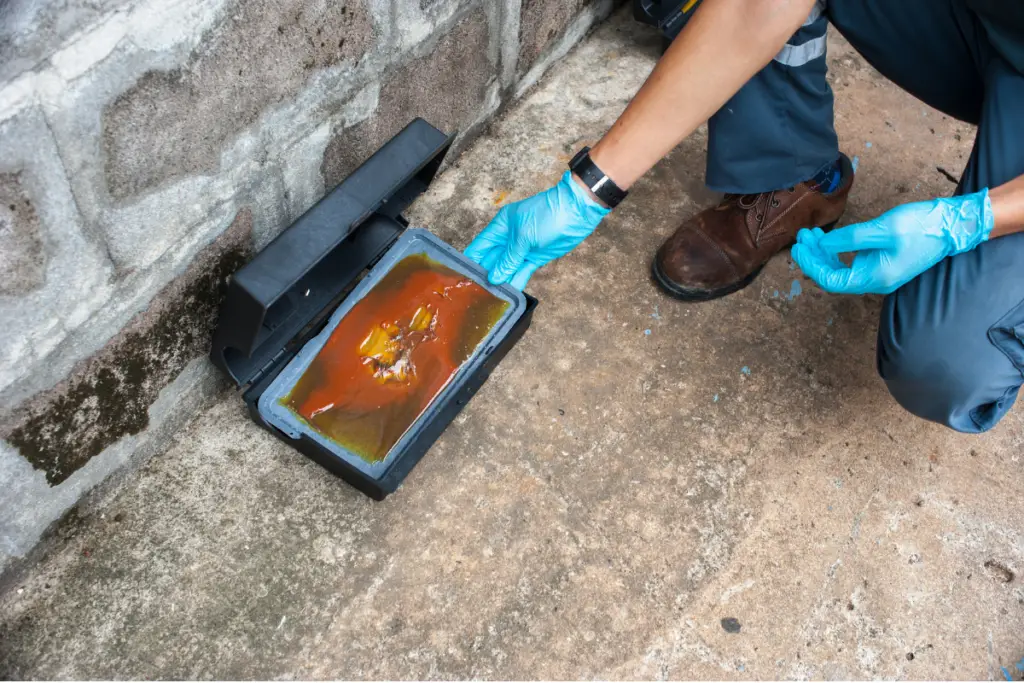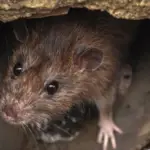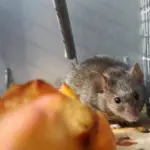Rat glue traps are a popular and effective method of controlling rodent infestations. They are easy to use, inexpensive, and can be placed in a variety of locations.
The traps work by using a strong adhesive to trap the rodent, preventing it from escaping.
One of the benefits of using a rat glue trap is that it is a non-toxic method of pest control. Unlike traditional poisons, glue traps do not contain harmful chemicals that can be dangerous to humans or pets.
This makes them a safe option for households with children or animals.
However, there are some ethical concerns regarding the use of glue traps. Some people believe that they are an inhumane way of killing rats and mice, as the rodents may suffer for an extended period before eventually dying.
Others argue that the traps are a necessary evil in controlling rodent populations and preventing the spread of disease.
Overall, the effectiveness and ethical considerations of rat glue traps make them a controversial but popular option for pest control.

Table of Contents
The Problem with Rat Glue Traps
Rat glue traps are a popular method of rodent control, but they come with a host of problems that make them a less than ideal solution. Here are a few reasons why:
Inhumane Treatment of Animals
Glue traps are often considered inhumane because they cause animals to suffer needlessly. When an animal gets stuck on a glue trap, it can take hours or even days for it to die.
During this time, the animal is unable to move or defend itself, making it vulnerable to predators and other dangers.
Ineffective at Controlling Rat Populations
Glue traps are not an effective way to control rat populations. They may catch a few rats, but they are unlikely to eliminate an infestation.
Rats are intelligent animals that can learn to avoid traps, and they may become wary of glue traps after seeing other rats get caught.
Potential Health Risks
Glue traps can pose a health risk to humans and other animals. When a rat gets stuck on a glue trap, it may defecate and urinate, potentially spreading disease and bacteria.
If a child or pet comes into contact with a glue trap, they may also be exposed to these health risks.
Environmental Concerns
Glue traps are not environmentally friendly. They are made from non-biodegradable materials and can take years to break down in a landfill.
Additionally, they can harm non-target species, such as birds and other wildlife, that may become stuck on them.
Overall, rat glue traps are not a humane, effective, or environmentally friendly way to control rat populations.
There are many other methods of rodent control that are more effective and less harmful to animals and the environment.
How Rat Glue Traps Work
Rat glue traps are a common method used to catch rodents. These traps consist of a sticky adhesive surface that traps the rat when it walks over it.
The glue is strong enough to hold the rat in place, making it impossible for the rat to escape. Once the rat is caught, the trap needs to be disposed of.
Glue traps are easy to use. Simply place the trap where the floor meets the wall in areas where rodents travel, such as near rodent signs like hair, droppings, or damage.
The trap has a low profile, so the rodent will not become suspicious when it happens upon the trap. It will continue to move forward, and once it steps on the glue, it will become stuck.
One of the advantages of rat glue traps is that they do not use poison, making them safer for children and pets.
They are also relatively inexpensive and easy to dispose of. However, there are some disadvantages to using glue traps.
For example, they can be inhumane, causing the rat to suffer for an extended period before it dies.
They can also catch other animals, such as birds or small mammals, which can be harmful to the environment.
Prices pulled from the Amazon Product Advertising API on:
Product prices and availability are accurate as of the date/time indicated and are subject to change. Any price and availability information displayed on [relevant Amazon Site(s), as applicable] at the time of purchase will apply to the purchase of this product.
Another disadvantage of rat glue traps is that they are not always effective. Rats are intelligent animals, and they can sometimes avoid the traps.
They may also become wary of the traps if they see other rats caught in them. In addition, if the trap is not placed in the right location, it may not catch any rats.
Overall, rat glue traps can be an effective way to catch rodents, but they are not without their drawbacks.
It is essential to use them responsibly and to dispose of them properly to avoid harming other animals or the environment.
The Dangers of Rat Glue Traps
Rat glue traps are a popular method for catching rodents, but they come with a number of dangers.
This section will explore the inhumane treatment of animals and the health risks to humans associated with rat glue traps.
Inhumane Treatment of Animals
Rat glue traps are often used as an alternative to snap traps, but they are far from humane. The traps consist of a board coated with a sticky adhesive that ensnares any small animal that comes into contact with it.
Once an animal is caught, it struggles to free itself and often dies a slow, painful death from starvation, dehydration, or suffocation.
Glue traps are indiscriminate and can catch any small animal that wanders across or lands on its surface.
This includes not only rats but also birds, squirrels, and other innocent creatures. The traps are also often used in areas where pets or children can come into contact with them, leading to accidental trapping and injury.
Health Risks to Humans
Rat glue traps also pose health risks to humans. The adhesive used on the traps can contain toxic chemicals that can be harmful if inhaled or ingested.
The traps can also attract other pests, such as flies and cockroaches, which can carry diseases and contaminate food.
In addition, handling the traps can be dangerous. The adhesive can stick to skin and clothing, making it difficult to remove.
If the adhesive comes into contact with the eyes, it can cause irritation or damage. In some cases, people have accidentally ingested the adhesive, leading to serious health problems.
Overall, rat glue traps are not only inhumane but also pose significant health risks to humans.
There are more effective and humane methods for controlling rodent populations, such as using snap traps or hiring a professional pest control service.
Alternatives to Rat Glue Traps
When it comes to catching rats, glue traps are not always the best option. They can be inhumane and cause unnecessary suffering to the animal.
Fortunately, there are several alternatives to rat glue traps that are just as effective and much more humane.
Snap Traps
Snap traps are the most traditional and widely used method of catching rats. They are simple to use and very effective.
Snap traps work by using a spring-loaded bar to quickly snap shut and kill the rat when it takes the bait.
There are several types of snap traps available, including wooden snap traps and plastic snap traps.
One of the advantages of snap traps is that they can be reused multiple times, making them a more cost-effective option.
Prices pulled from the Amazon Product Advertising API on:
Product prices and availability are accurate as of the date/time indicated and are subject to change. Any price and availability information displayed on [relevant Amazon Site(s), as applicable] at the time of purchase will apply to the purchase of this product.
Electronic Traps
Electronic traps are a more high-tech alternative to traditional snap traps. They work by using an electric shock to kill the rat when it enters the trap.
Electronic traps are easy to use and can be set up in just a few minutes.
One of the advantages of electronic traps is that they are very humane. They kill the rat instantly, without causing any unnecessary suffering.
Electronic traps are also very effective, with a success rate of over 90%.
Prices pulled from the Amazon Product Advertising API on:
Product prices and availability are accurate as of the date/time indicated and are subject to change. Any price and availability information displayed on [relevant Amazon Site(s), as applicable] at the time of purchase will apply to the purchase of this product.
Live Traps
Live traps are a humane alternative to both glue traps and snap traps. They work by using bait to lure the rat into a cage or trap.
Once the rat is inside, the trap can be closed, and the rat can be safely released into the wild.
Live traps are a great option for those who want to catch rats without harming them.
They are also very effective, with a success rate of over 80%.
How to Use Rat Glue Traps Safely
Using rat glue traps can be an effective way to control rodent infestations, but it’s important to use them safely to avoid harm to both humans and animals.
Here are some tips on how to use rat glue traps safely:
1. Choose the right location
When placing rat glue traps, it’s important to choose the right location. Place the traps where rats are likely to travel, such as along walls, in corners, and near food sources.
Avoid placing traps in areas where children and pets can easily access them.
2. Use bait
To increase the effectiveness of rat glue traps, use bait such as peanut butter or bacon bits. Place a small amount of bait in the center of the trap to attract rats.
3. Check the traps regularly
Check the traps regularly, at least once a day, to see if any rats have been caught. If a rat is caught, dispose of the trap and the rat safely.
Wear gloves and use a plastic bag to avoid direct contact with the rat or the trap.
4. Dispose of traps properly
When disposing of rat glue traps, wrap them in plastic and dispose of them in the trash. Do not flush them down the toilet or throw them in the recycling bin.
If a rat is caught in the trap, dispose of it along with the trap.
5. Use caution around children and pets
Rat glue traps should be used with caution around children and pets. Keep the traps out of reach of children and pets, and supervise them when they are near the traps.
If a child or pet comes into contact with a rat glue trap, seek medical attention immediately.
By following these tips, you can use rat glue traps safely and effectively to control rodent infestations.
Conclusion
While rat glue traps may seem like a quick and easy solution to a rodent problem, they are not without their drawbacks.
As discussed earlier, glue traps can be inhumane and cause unnecessary suffering to the trapped animals. In addition, glue traps can be messy and difficult to dispose of properly.
It is important to note that glue traps are not always effective in trapping rats, and even when they do work, they only capture one rat at a time.
This means that if you have a larger infestation, you may need to use multiple traps, which can be time-consuming and expensive.
Furthermore, glue traps can pose a risk to non-target animals, such as pets or wildlife, who may accidentally become trapped in the sticky adhesive.
It is important to use caution when placing glue traps and to keep them out of reach of other animals.
Overall, while glue traps may seem like a convenient solution to a rat problem, they come with several drawbacks and ethical considerations.
It is important to consider alternative methods of pest control, such as snap traps or live traps, which are more humane and effective in the long run.
- How to Build a Planter Box for Bamboo: A Step-by-Step Guide

- Can Robotic Lawnmowers Handle Steep Slopes?

- Do You Need a Specific Lawn for a Robotic Lawnmower? Expert Advice

- Are Robotic Lawnmowers Safe for Pets and Children? Safety Features of Robotic Lawnmowers

- Why Use Robotic Lawnmowers? Advantages of Using a Robotic Lawnmower

- Is the GARDENA SILENO City 300 Cordless or Corded? A Clear Answer

































